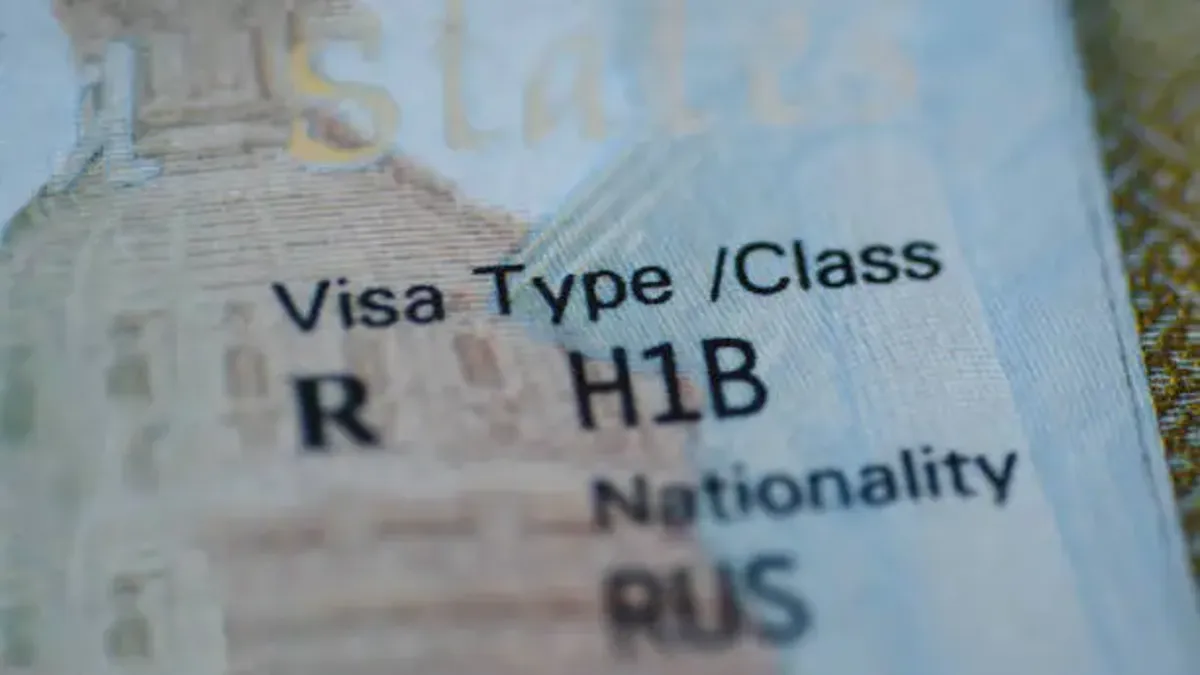When people ask about H-1B visa and green card changes, they’re not just looking for technical updates — they’re seeking to understand how U.S. immigration policies are reshaping opportunity, innovation, and global talent mobility. In short, 2025 marks one of the most significant transitional periods for both H-1B and employment-based green cards in over a decade. Reforms are targeting modernization, transparency, and fairness: tighter oversight of the lottery system, new digital filing systems, merit-based selection adjustments, and faster green card backlogs for long-term skilled workers. These changes could redefine how employers hire foreign talent and how skilled professionals plan their American future – H 1B Visa Green Card Changes.
The following analysis explores the intersection of policy, economy, and human aspiration. The H-1B and green card reforms are not isolated bureaucratic tweaks — they’re reflections of a deeper transformation in how the United States manages labor, innovation, and migration. Over the next few sections, we’ll examine the reasons behind these changes, the proposed updates, who benefits, and how industries from tech to healthcare are recalibrating. At stake is more than paperwork; it’s the future of the American workforce.
A New Era for High-Skilled Immigration
The H-1B visa, first established in 1990, allows U.S. companies to employ foreign workers in specialty occupations requiring theoretical or technical expertise. It has long been a bridge for global talent — engineers, researchers, doctors, and software developers who power Silicon Valley and beyond. Yet critics argue the system has lagged behind modern realities.
For years, the annual cap of 85,000 visas (65,000 regular and 20,000 for advanced-degree holders) created a bottleneck. Demand consistently exceeded supply — with over 750,000 applications in 2024 alone. Recent reforms, initiated under new Department of Homeland Security (DHS) guidelines, aim to address inequities and strengthen integrity in the lottery process.
“The challenge isn’t that America lacks talent,” said policy analyst Maria Iqbal. “It’s that the immigration pipeline hasn’t kept pace with the economy’s needs.”
Among the headline updates:
- A beneficiary-based lottery system designed to prevent multiple submissions by the same applicant.
- Expanded digital verification and compliance tools to track employer authenticity.
- Streamlined cap-exempt visa categories for research institutions and startups.
These changes mark a shift from a quantity-based lottery toward a quality-driven, transparent process – H 1B Visa Green Card Changes.
The Green Card Connection
The employment-based green card system — formally known as the EB categories (EB-1 through EB-5) — is tightly linked to H-1B visas. Many H-1B holders transition to permanent residency after years of work in the U.S. However, per-country limits, particularly for India and China, have created decades-long backlogs.
Recent proposals from the Department of Labor and USCIS (U.S. Citizenship and Immigration Services) focus on reducing these delays through digitization, dynamic quota adjustments, and recapture of unused visas. In addition, new rules may prioritize long-term U.S. workers with consistent employment history, giving them smoother pathways to permanent residency.
“The goal is to reward those who’ve contributed years to the U.S. economy,” explained immigration attorney Samuel Rhodes. “It’s about fairness and retention.”
The new framework aims to align immigration with economic competitiveness — ensuring that talent nurtured in the U.S. isn’t lost to global competitors.
Table 1: Key Differences Between Old and Updated H-1B / Green Card Processes
| Aspect | Old Framework (Pre-2025) | Updated Framework (2025+) |
|---|---|---|
| Application System | Employer-driven, paper-heavy | Digital-first, transparency-based |
| Lottery Method | Random employer submissions | Beneficiary-based to prevent duplicates |
| Green Card Backlog | 10–20 years for some countries | Quota rebalancing under review |
| Data Security | Minimal integration | Blockchain-enabled verification pilot |
| Review Timeline | Average 8–10 months | Target 4–6 months under modernization |
These reforms, while still being phased in, indicate a broader administrative shift toward modernization and data integrity – H 1B Visa Green Card Changes.
Why the Changes Were Necessary
The need for reform stems from decades of imbalance between policy and reality. The American economy has transformed — tech, healthcare, renewable energy, and AI are now global enterprises relying heavily on transnational expertise. Yet immigration policy remained tethered to the 1990s.
The H-1B visa cap has not increased in over 30 years, even as the U.S. GDP tripled and digital industries exploded. This mismatch led to inefficiencies and resentment — both from employers seeking workers and from domestic labor groups advocating fairness.
“The world has changed since the first H-1B visas were issued,” said economist Rajesh Mehta. “What we need now is a system that reflects today’s global competition, not yesterday’s fears.”
At the same time, fraud concerns — especially from fake employer submissions — forced policymakers to tighten screening. The introduction of digital cross-checking through USCIS systems aims to verify employer legitimacy and prevent gaming of the lottery.
The Human Impact: Workers and Families in Limbo
Behind the policy charts lie human stories — of professionals whose futures hinge on renewal cycles, green card queues, and shifting regulations. Many H-1B holders spend years building lives in the U.S. only to face uncertainty due to backlogs. The reforms promise gradual relief but not immediate resolution – H 1B Visa Green Card Changes.
“It’s hard to plan your life when your legal status resets every three years,” shared an H-1B worker in San Francisco. “You buy a home, your kids go to school here — but you still don’t know if you belong.”
For Indian and Chinese nationals, who make up over 70% of H-1B approvals, these changes could ease but not erase delays. Proposals for visa recapture and advanced adjustment filings aim to reduce wait times by allowing earlier stages of permanent residency while still on temporary status.
The Employer Perspective: Balancing Access and Accountability
For U.S. employers, the reforms bring both relief and new responsibilities. The digital filing system reduces administrative burden but also increases scrutiny. Employers must prove job legitimacy, salary fairness, and adherence to labor standards.
Table 2: Employer Obligations Under the New Rules
| Requirement | Old Process | New 2025 Framework |
|---|---|---|
| Labor Condition Application (LCA) | Manual submission | Automated compliance verification |
| Wage Verification | Periodic audits | Real-time wage tracking tools |
| Remote Work | Limited recognition | Expanded provisions for hybrid models |
| Compliance Audits | Reactive | Proactive digital monitoring |
Tech firms, universities, and hospitals welcome modernization but remain wary of increased oversight. Still, most agree that a transparent system could restore public confidence in skilled immigration.
“Accountability and opportunity aren’t opposites — they’re the foundation of sustainable growth,” said Lisa Han, HR Director of a major biotech company.
Green Card Backlog Reform and Legislative Momentum
The conversation around employment-based green card changes has gained momentum across political lines. A bipartisan bill introduced earlier this year seeks to – H 1B Visa Green Card Changes:
- Recapture unused visas from past decades (estimated 250,000+).
- Remove per-country caps that disproportionately affect high-application countries.
- Expand digital processing to accelerate adjustment of status.
- Create transitional status for long-wait applicants to travel and change jobs freely.
While not all provisions will pass, the general direction reflects consensus that current backlogs are unsustainable. The backlog for Indian professionals alone exceeds 1.2 million, with some waiting 20 years for a green card.
“Talent should not expire while waiting for paperwork,” noted policy advocate Daniel Ruiz. “These reforms are an investment in people who already invest in America.”
Bullet Section — What Workers and Employers Should Know in 2025
- H-1B lottery now uses beneficiary-based registration — multiple filings no longer increase odds.
- Digital LCA and e-verification reduce paperwork but heighten compliance responsibility.
- Green card recapture proposals could free hundreds of thousands of unused visas.
- Premium processing expansion means faster adjudication for certain green card categories.
- Per-country limits under reconsideration; backlog relief expected gradually.
- Remote and hybrid roles formally recognized under updated labor policies.
The Intersection of Technology and Immigration
One of the most transformative elements of the 2025 immigration shift is the integration of technology. USCIS’s transition to a cloud-based digital environment enables end-to-end electronic case management. Artificial intelligence tools assist in fraud detection and case prioritization. Blockchain pilots ensure employer authenticity.
This digital transformation aims to make immigration both faster and more equitable — automating repetitive tasks while focusing human officers on complex adjudications. The change also reduces costs and enables data transparency.
“Digitization is not just convenience,” said DHS official Karen Ortega. “It’s a safeguard for both the worker and the employer.”
The shift mirrors global trends — Canada, Australia, and Singapore already use AI-assisted immigration systems. The U.S. catching up signals modernization rather than restriction.
Economic Implications of the Reforms
The broader economic impact of these immigration adjustments extends beyond administrative efficiency. Skilled immigration fuels entrepreneurship, innovation, and tax revenue. Roughly 45% of U.S. Fortune 500 companies were founded by immigrants or their children. A fair, efficient system keeps that pipeline alive.
In industries like AI, semiconductors, and healthcare, talent shortages persist. The H-1B and green card updates could relieve hiring pressures by expanding reliability in the process. Stable visa frameworks encourage both foreign investment and domestic job creation.
“Predictability is what employers crave,” said venture capitalist Omar Leland. “Immigration reform isn’t just humanitarian — it’s economic infrastructure.”
Table 3: Economic Outcomes of Immigration Modernization
| Impact Area | Expected Effect (2025–2030) |
|---|---|
| Labor Shortage Relief | Moderate, especially in tech and healthcare |
| GDP Contribution | Estimated +0.3% annual growth |
| Tax Revenue | Increased due to higher long-term retention |
| Innovation Rate | Boost from stabilized workforce mobility |
| Foreign Investment | Higher due to talent certainty |
The intersection of immigration and innovation remains a defining American strength. These reforms, while technical, preserve that legacy.
Global Competition for Talent
The world is competing for skilled immigrants, and the U.S. can no longer assume dominance. Canada, the U.K., and Germany have streamlined pathways for STEM graduates and tech professionals. The U.S. reforms arrive as a response to this geopolitical reality — a bid to remain competitive in the global race for human capital.
“Every country is drafting its own version of a ‘smart visa,’” says researcher Elena Fischer. “The U.S. can’t afford to lose its magnetism.”
By aligning H-1B and green card policies with global standards, the U.S. hopes to reassert leadership in high-tech innovation and research.
Cultural Dimensions: Integration and Belonging
Beyond economics, immigration reforms touch identity. Thousands of foreign professionals have built families, communities, and businesses in the U.S., yet many live in prolonged uncertainty. The green card modernization initiative, by providing clearer timelines, represents more than policy — it symbolizes acknowledgment.
Families long separated by visa limitations may now see pathways to stability. Universities benefit as international students envision long-term futures. The reforms, if executed fairly, could rebuild public trust in an immigration system often criticized as opaque.
“When policy recognizes humanity, productivity follows,” notes sociologist Dr. Anjali Rao. “Integration is the true measure of success.”
Challenges Ahead: Implementation and Politics
While the changes are ambitious, challenges remain. Bureaucratic inertia, technical glitches, and political cycles could slow implementation. Immigration reform has historically been vulnerable to shifting administrations. Critics warn that without bipartisan support, these reforms risk becoming fragmented pilot programs rather than enduring systems.
Still, the public mood toward skilled immigration remains positive. Surveys show over 70% of Americans support attracting high-skill workers — a rare point of agreement in a polarized era.
The Legal Path Forward
For professionals and employers, legal preparation is key. Immigration lawyers recommend early filings, detailed documentation, and digital readiness for the new system. While automation reduces some hurdles, compliance scrutiny has intensified.
Companies are also advised to maintain transparent wage and role documentation to meet the new digital verification standards. Applicants should monitor USCIS updates on electronic status tracking and fee adjustments expected later this year.
“Modernization means accountability,” explained immigration consultant Renee Sullivan. “Digital systems remember everything — accuracy matters more than ever.”
Table 4: Common Pitfalls and Solutions Under New Rules
| Common Issue | Impact | Solution |
|---|---|---|
| Multiple Submissions | Disqualification | File once per beneficiary |
| Wage Discrepancy | Application rejection | Verify LCA through digital systems |
| Missing Digital Records | Delays | Upload scanned, authenticated documents |
| Expired Prevailing Wage Data | Compliance breach | Use latest DOL benchmarks |
| Outdated Contact Info | Missed notifications | Register updated email/portal access |
Preparedness ensures smoother navigation through this evolving landscape.
Bullet Section — The Future Outlook of Skilled Immigration
- Green card digitization to expand fully by 2026.
- Employer transparency becomes central to immigration integrity.
- STEM prioritization likely to continue shaping visa approvals.
- Backlog reduction efforts will take years but show steady progress.
- AI-assisted adjudication may redefine future USCIS operations.
Conclusion
The H-1B visa and green card changes of 2025 represent more than procedural modernization — they signify a philosophical shift in how America views its relationship with global talent. Efficiency, fairness, and digital transformation now define the immigration system once bogged down by paper and politics. For employers, this means reliability; for workers, a clearer path; for the nation, renewed competitiveness.
Yet challenges endure: backlogs won’t vanish overnight, and political continuity will determine success. What’s clear is that the U.S. has recognized immigration not merely as a border issue but as an engine of innovation.
As the world watches, these reforms may serve as a model for balancing national interests with human potential — proving once again that America’s strength lies not just in its policies, but in its openness to those who help build its future.
FAQs
1. What is the main change in the H-1B process for 2025?
The new beneficiary-based registration ensures each applicant is entered once, preventing multiple lottery submissions by different employers.
2. How do green card reforms help long-waiting professionals?
They prioritize long-term U.S. workers, recapture unused visas, and digitize the process to speed up backlog reduction.
3. Will the H-1B visa cap increase?
No official increase yet, but discussions continue about adjusting caps for STEM and startup roles.
4. What’s the timeline for digital transformation?
Full online filing and tracking are expected to become mandatory for most employment-based categories by late 2026.
5. How do these changes impact employers?
Employers face tighter verification rules and automated audits but benefit from faster processing and improved predictability.







